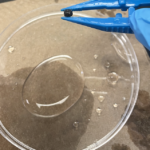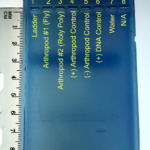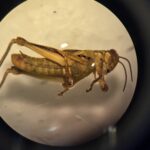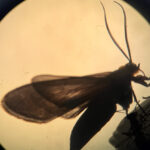Sample information |
|
| Picture |

|
|---|---|
| Location | |
| Collection date | 05/12/2025 |
| Captive / Cultivated? | Wild-caught |
| Group | California Academy of Mathematics and Science |
| Observations | The pill bug was found in the soil of our school’s garden. It was also attempting to dig into the soil. It had a hard exoskeleton, was about the size of a grain of rice, and was dark gray. |
| Putative identification | Arthropoda Malacostraca Isopoda Armadillidae Armadillidium Armadillidium vulgare |
Methods |
|
| Extraction kit | DNeasy (Qiagen) blood and tissue kit |
| DNA extraction location | Whole arthropod |
| Single or Duplex PCR | Duplex Reaction |
| Gel electrophoresis system | Standard electrophoresis system Bio-Rad |
| Buffer | 1X TAE |
| DNA stain | 100X Fast Blast |
| Gel images |

|
| Protocol notes | The arthropods were caught and then ground to proceed to the DNA extraction and purification process. We did come across an issue with our second arthropod sample containing the pill bug, as the exoskeleton was not removed to lessen the risk of being unable to extract sufficient DNA. This led to our spin column being clogged for a significant amount of time, which we fixed by moving the sample around with a pipette tip. However, this might have decreased the efficiency of our DNA sample. Once our experimental and control samples were prepped, we moved on to the PCR protocol. Samples and our PCR cocktail were added to each of our PCR tubes, which were then put into our MiniOne PCR machine. Finally, loading dye was added to the separated portions of our PCR samples and was loaded into our gel. Our final gel was stained with 100X Fast Blast and put onto a light box for imaging. |
Results |
|
| Wolbachia presence | Unknown |
| Confidence level | Low |
| Explanation of confidence level | In the third lane containing our pill bug sample, no bands were present when there should have been at least one band. Therefore, we failed to conclude whether the arthropod tested positive for Wolbachia. Such inconclusive results were likely due to issues during the DNA extraction process, which likely occurred when using the whole arthropod rather than removing its exoskeleton. Doing so resulted in our spin column being clogged, which we then unclogged with a pipette tip, which might have decreased the efficiency of our DNA. As for our positive arthropod control, we did have an issue with it since it only had one band when there should have been two. The negative arthropod control and the positive DNA control did work. However, due to our inconsistencies in our data derived from our gel, we are not confident about our overall lab results. |
| Wolbachia 16S sequence | |
| Arthropod COI sequence |
|
| Summary | |
 Differential Grasshopper – Melanoplus differentialis
Differential Grasshopper – Melanoplus differentialis Pill Bug (Armadillidium vulgare) – Draft
Pill Bug (Armadillidium vulgare) – Draft Melanoplus Femurrubrum
Melanoplus Femurrubrum Grasshopper – Orthoptera
Grasshopper – Orthoptera Cisseps Fulvicollis
Cisseps Fulvicollis